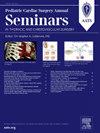Mitral Valve Repair Techniques in Neonates and Infants
Q2 Medicine
引用次数: 0
Abstract
Mitral valve repair is often preferred over replacement due to the preservation of native valve function, allowing for somatic growth and resulting in fewer complications and reoperations. Although there are no randomized trials comparing repair and replacement specifically in this age group, retrospective studies still indicate better long-term survival and lower reoperation rates with repair. While neonates and infants experience higher mortality rates compared to older children, freedom from re-intervention is durable in the survivors and matches that of older children. Especially compression suture annuloplasty and chordal replacement using Gore-Tex sutures have shown favorable outcomes, but the rarity of the condition makes it challenging to train new surgeons. Utilizing detailed video documentation could help bridge this educational gap. While advancements in materials for valve repair in neonates and infants have been slow, emerging options like new materials that grow with the patient offer potential for future innovation. In complex cases such as Shone's syndrome, new techniques, including an-bloc replacement of the aorta and mitral valve, may improve outcomes.
新生儿和婴儿二尖瓣修复技术
二尖瓣修复通常优于置换,因为保留了原有的瓣膜功能,允许体生长,导致较少的并发症和再手术。虽然没有针对该年龄组的比较修复和置换的随机试验,但回顾性研究仍然表明修复有更好的长期生存率和更低的再手术率。虽然与大龄儿童相比,新生儿和婴儿的死亡率更高,但幸存者免于再干预的自由是持久的,与大龄儿童相同。特别是压缩缝合环成形术和使用Gore-Tex缝线的脊索置换术已显示出良好的效果,但这种情况的罕见性使得培训新外科医生具有挑战性。利用详细的视频文档可以帮助弥合这种教育差距。虽然用于新生儿和婴儿瓣膜修复的材料进展缓慢,但新兴的选择,如与患者一起成长的新材料,为未来的创新提供了潜力。对于像肖尼综合征这样的复杂病例,包括主动脉和二尖瓣整体置换术在内的新技术可能会改善结果。
本文章由计算机程序翻译,如有差异,请以英文原文为准。
求助全文
约1分钟内获得全文
求助全文
来源期刊

Pediatric Cardiac Surgery Annual
Medicine-Surgery
CiteScore
3.80
自引率
0.00%
发文量
7
期刊介绍:
The Pediatric Cardiac Surgery Annual is a companion to Seminars in Thoracic and Cardiovascular Surgery . Together with the Seminars, the Annual provides complete coverage of the specialty by focusing on important developments in pediatric cardiac surgery. Each annual volume has an expert guest editor who invites prominent surgeons to review the areas of greatest change in pediatric cardiac surgery during the year. Topics include 1) Complete Atrioventricular Canal; 2) New Concepts of Cardiac Anatomy and Function -- The Helical Heart; 3) Valve Reconstruction (Replacement) in Congenital Heart Disease; 4) Evolving Developments in Congenital Heart Surgery.
 求助内容:
求助内容: 应助结果提醒方式:
应助结果提醒方式:


